Business Law Report: Legal Sources, Compliance, Impacts & Solutions
VerifiedAdded on 2024/06/05
|21
|5303
|149
Report
AI Summary
This business law report examines the English legal system's framework for addressing business problems. It discusses the primary and secondary sources of law, including jurisprudence, legislation, and European law, and the role of government in lawmaking through the legislature. The report highlights the application of statutory and common law in justice courts, emphasizing compliance with laws such as the Consumer Rights Act 2015 and the Corporation Act. It evaluates the effectiveness of recent legal reforms, including alternative dispute resolution mechanisms. Through case studies, the report illustrates the potential impact of company, employment, and contract law on businesses and suggests appropriate legal solutions for issues like contract termination, insolvency, and liquidation, also recommending alternative legal solutions and comparing their effectiveness. Desklib provides access to this and other solved assignments.
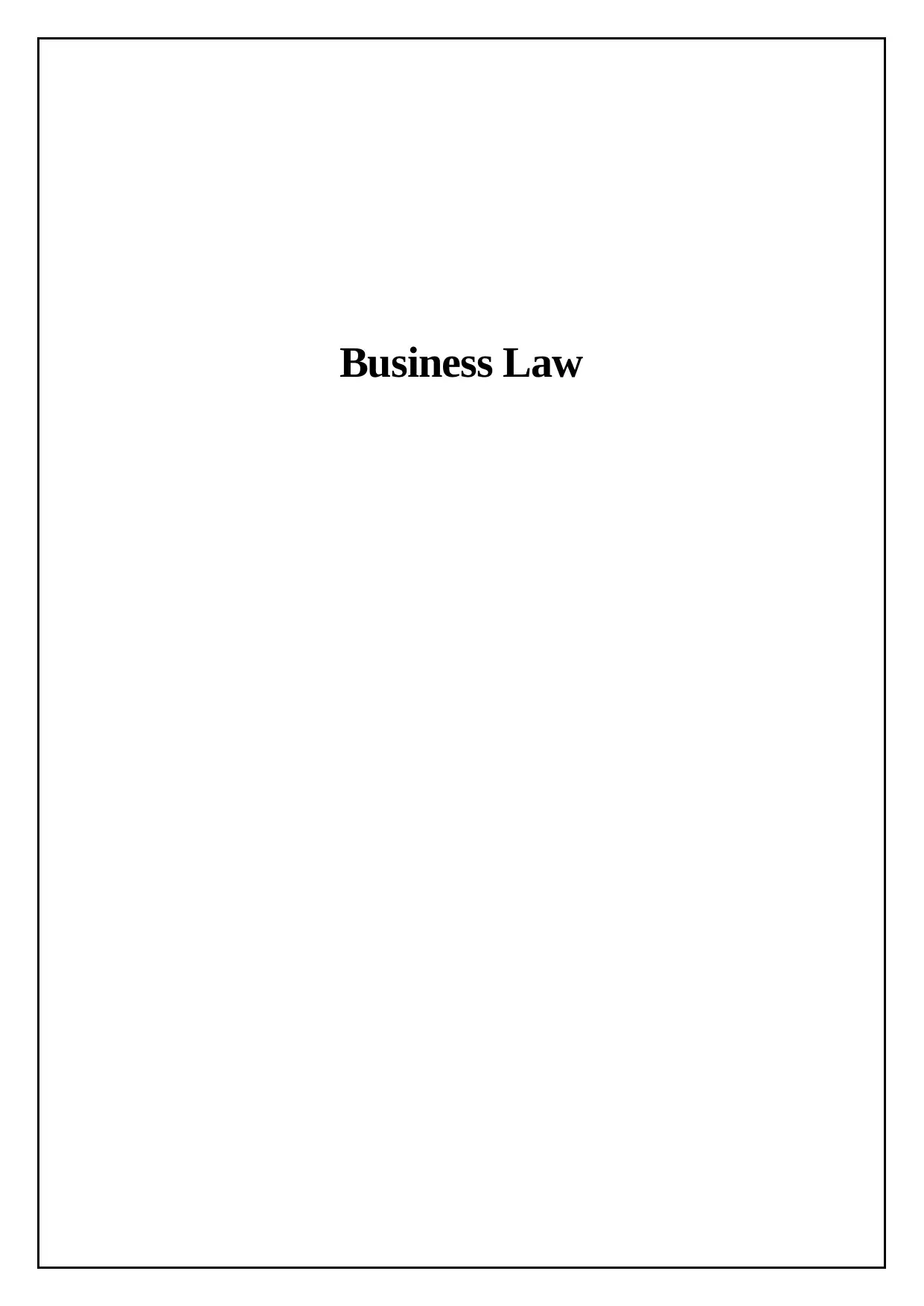
Business Law
Paraphrase This Document
Need a fresh take? Get an instant paraphrase of this document with our AI Paraphraser
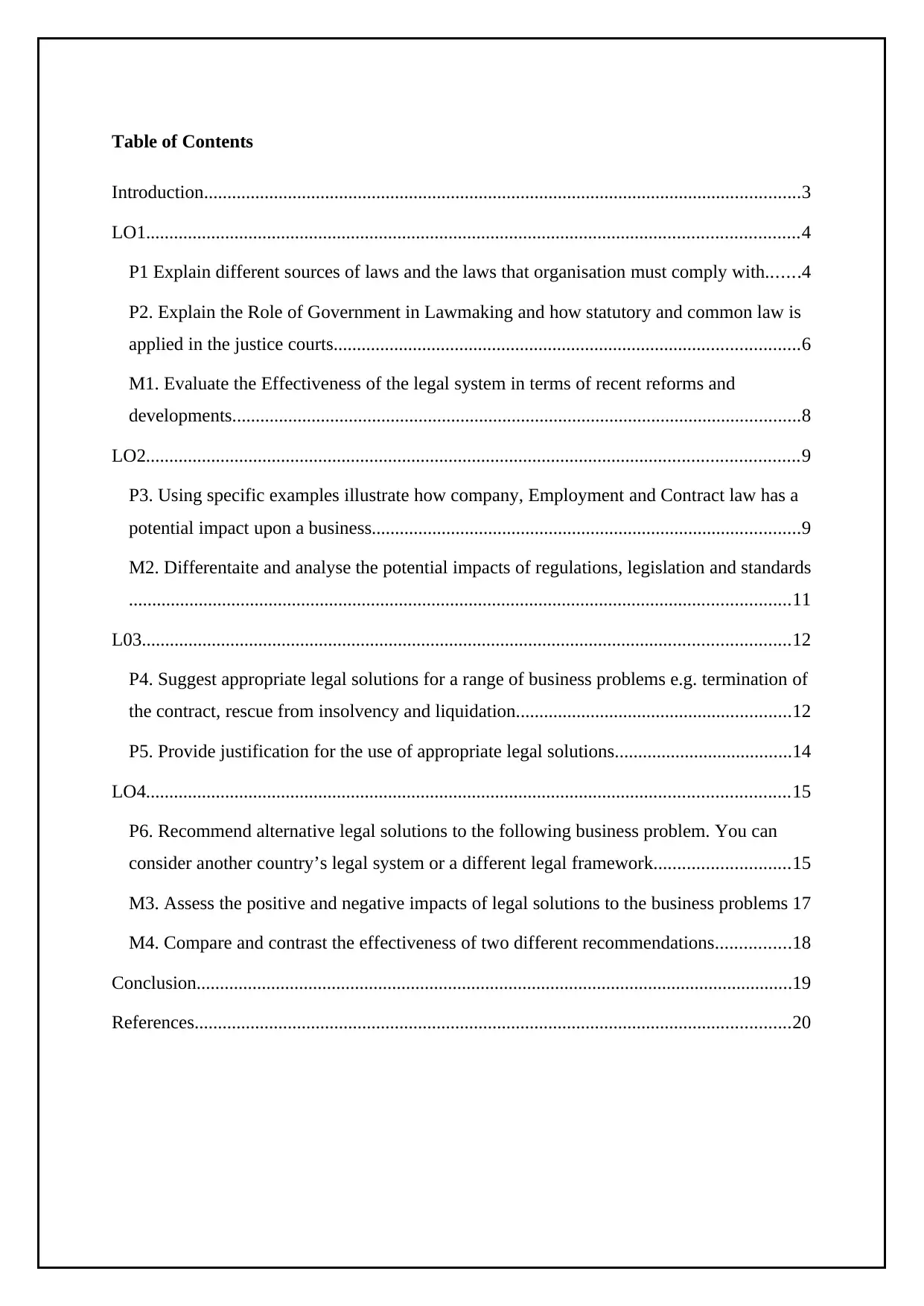
Table of Contents
Introduction................................................................................................................................3
LO1............................................................................................................................................4
P1 Explain different sources of laws and the laws that organisation must comply with.......4
P2. Explain the Role of Government in Lawmaking and how statutory and common law is
applied in the justice courts....................................................................................................6
M1. Evaluate the Effectiveness of the legal system in terms of recent reforms and
developments..........................................................................................................................8
LO2............................................................................................................................................9
P3. Using specific examples illustrate how company, Employment and Contract law has a
potential impact upon a business............................................................................................9
M2. Differentaite and analyse the potential impacts of regulations, legislation and standards
..............................................................................................................................................11
L03...........................................................................................................................................12
P4. Suggest appropriate legal solutions for a range of business problems e.g. termination of
the contract, rescue from insolvency and liquidation...........................................................12
P5. Provide justification for the use of appropriate legal solutions......................................14
LO4..........................................................................................................................................15
P6. Recommend alternative legal solutions to the following business problem. You can
consider another country’s legal system or a different legal framework.............................15
M3. Assess the positive and negative impacts of legal solutions to the business problems 17
M4. Compare and contrast the effectiveness of two different recommendations................18
Conclusion................................................................................................................................19
References................................................................................................................................20
Introduction................................................................................................................................3
LO1............................................................................................................................................4
P1 Explain different sources of laws and the laws that organisation must comply with.......4
P2. Explain the Role of Government in Lawmaking and how statutory and common law is
applied in the justice courts....................................................................................................6
M1. Evaluate the Effectiveness of the legal system in terms of recent reforms and
developments..........................................................................................................................8
LO2............................................................................................................................................9
P3. Using specific examples illustrate how company, Employment and Contract law has a
potential impact upon a business............................................................................................9
M2. Differentaite and analyse the potential impacts of regulations, legislation and standards
..............................................................................................................................................11
L03...........................................................................................................................................12
P4. Suggest appropriate legal solutions for a range of business problems e.g. termination of
the contract, rescue from insolvency and liquidation...........................................................12
P5. Provide justification for the use of appropriate legal solutions......................................14
LO4..........................................................................................................................................15
P6. Recommend alternative legal solutions to the following business problem. You can
consider another country’s legal system or a different legal framework.............................15
M3. Assess the positive and negative impacts of legal solutions to the business problems 17
M4. Compare and contrast the effectiveness of two different recommendations................18
Conclusion................................................................................................................................19
References................................................................................................................................20
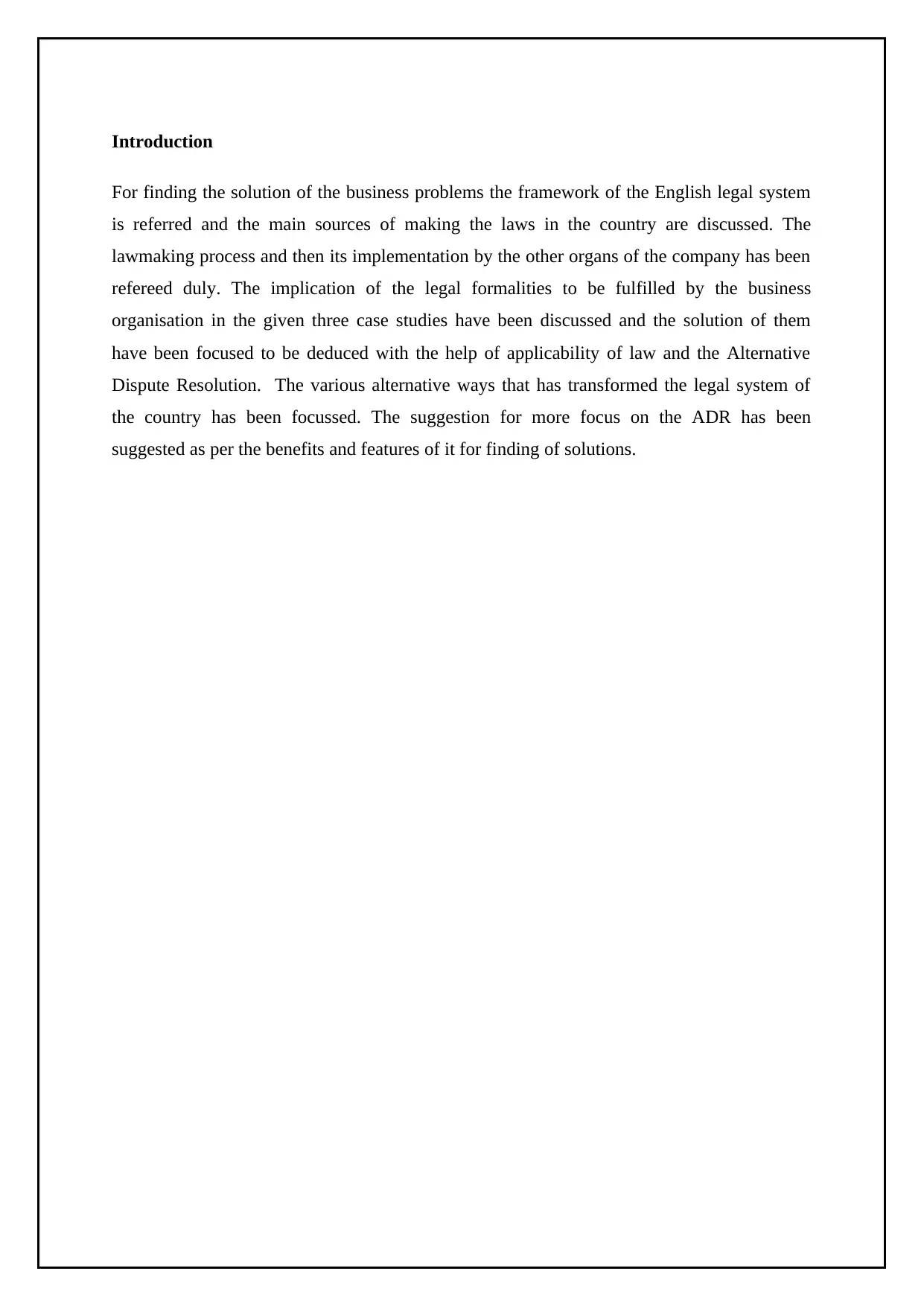
Introduction
For finding the solution of the business problems the framework of the English legal system
is referred and the main sources of making the laws in the country are discussed. The
lawmaking process and then its implementation by the other organs of the company has been
refereed duly. The implication of the legal formalities to be fulfilled by the business
organisation in the given three case studies have been discussed and the solution of them
have been focused to be deduced with the help of applicability of law and the Alternative
Dispute Resolution. The various alternative ways that has transformed the legal system of
the country has been focussed. The suggestion for more focus on the ADR has been
suggested as per the benefits and features of it for finding of solutions.
For finding the solution of the business problems the framework of the English legal system
is referred and the main sources of making the laws in the country are discussed. The
lawmaking process and then its implementation by the other organs of the company has been
refereed duly. The implication of the legal formalities to be fulfilled by the business
organisation in the given three case studies have been discussed and the solution of them
have been focused to be deduced with the help of applicability of law and the Alternative
Dispute Resolution. The various alternative ways that has transformed the legal system of
the country has been focussed. The suggestion for more focus on the ADR has been
suggested as per the benefits and features of it for finding of solutions.
⊘ This is a preview!⊘
Do you want full access?
Subscribe today to unlock all pages.

Trusted by 1+ million students worldwide
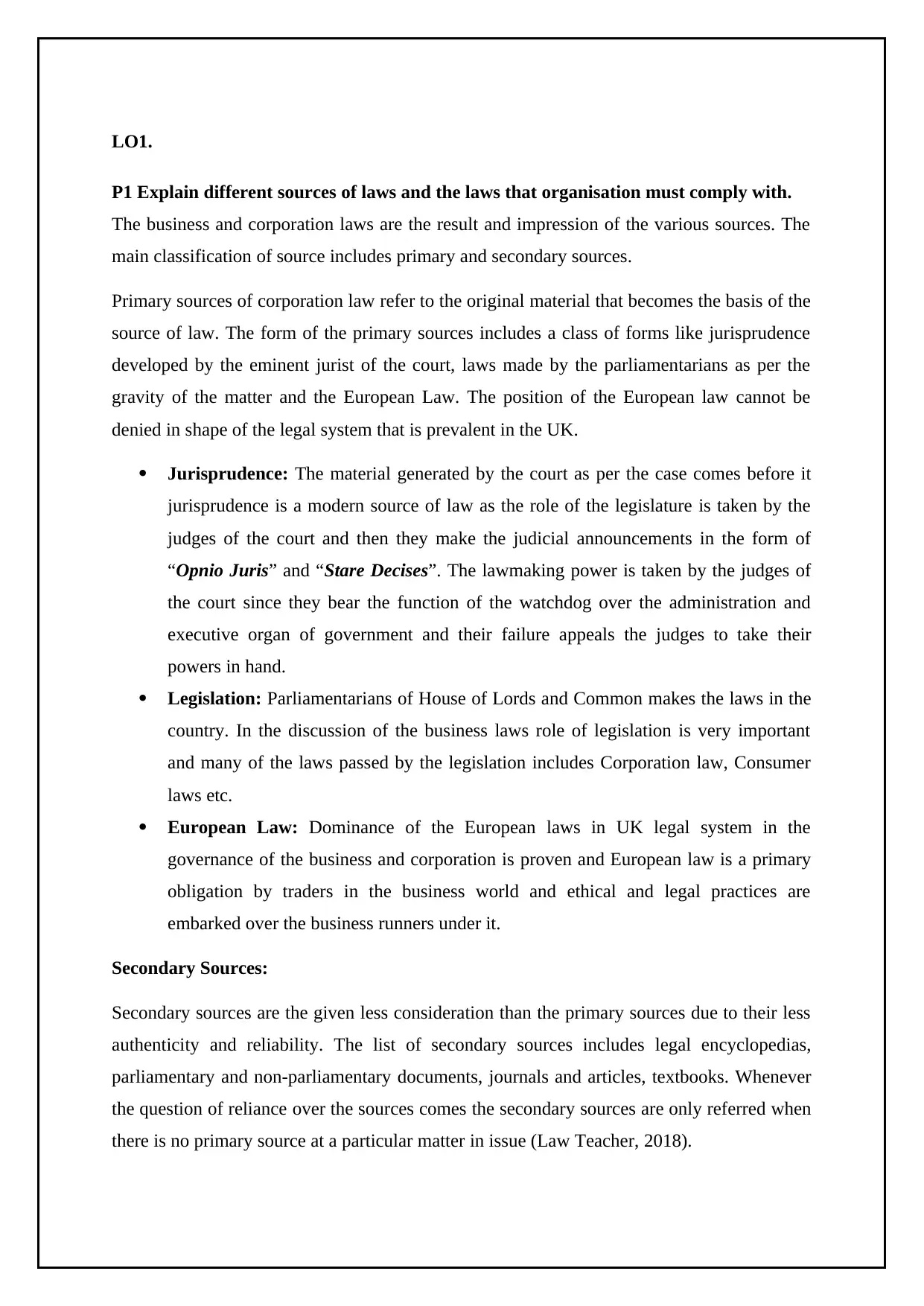
LO1.
P1 Explain different sources of laws and the laws that organisation must comply with.
The business and corporation laws are the result and impression of the various sources. The
main classification of source includes primary and secondary sources.
Primary sources of corporation law refer to the original material that becomes the basis of the
source of law. The form of the primary sources includes a class of forms like jurisprudence
developed by the eminent jurist of the court, laws made by the parliamentarians as per the
gravity of the matter and the European Law. The position of the European law cannot be
denied in shape of the legal system that is prevalent in the UK.
Jurisprudence: The material generated by the court as per the case comes before it
jurisprudence is a modern source of law as the role of the legislature is taken by the
judges of the court and then they make the judicial announcements in the form of
“Opnio Juris” and “Stare Decises”. The lawmaking power is taken by the judges of
the court since they bear the function of the watchdog over the administration and
executive organ of government and their failure appeals the judges to take their
powers in hand.
Legislation: Parliamentarians of House of Lords and Common makes the laws in the
country. In the discussion of the business laws role of legislation is very important
and many of the laws passed by the legislation includes Corporation law, Consumer
laws etc.
European Law: Dominance of the European laws in UK legal system in the
governance of the business and corporation is proven and European law is a primary
obligation by traders in the business world and ethical and legal practices are
embarked over the business runners under it.
Secondary Sources:
Secondary sources are the given less consideration than the primary sources due to their less
authenticity and reliability. The list of secondary sources includes legal encyclopedias,
parliamentary and non-parliamentary documents, journals and articles, textbooks. Whenever
the question of reliance over the sources comes the secondary sources are only referred when
there is no primary source at a particular matter in issue (Law Teacher, 2018).
P1 Explain different sources of laws and the laws that organisation must comply with.
The business and corporation laws are the result and impression of the various sources. The
main classification of source includes primary and secondary sources.
Primary sources of corporation law refer to the original material that becomes the basis of the
source of law. The form of the primary sources includes a class of forms like jurisprudence
developed by the eminent jurist of the court, laws made by the parliamentarians as per the
gravity of the matter and the European Law. The position of the European law cannot be
denied in shape of the legal system that is prevalent in the UK.
Jurisprudence: The material generated by the court as per the case comes before it
jurisprudence is a modern source of law as the role of the legislature is taken by the
judges of the court and then they make the judicial announcements in the form of
“Opnio Juris” and “Stare Decises”. The lawmaking power is taken by the judges of
the court since they bear the function of the watchdog over the administration and
executive organ of government and their failure appeals the judges to take their
powers in hand.
Legislation: Parliamentarians of House of Lords and Common makes the laws in the
country. In the discussion of the business laws role of legislation is very important
and many of the laws passed by the legislation includes Corporation law, Consumer
laws etc.
European Law: Dominance of the European laws in UK legal system in the
governance of the business and corporation is proven and European law is a primary
obligation by traders in the business world and ethical and legal practices are
embarked over the business runners under it.
Secondary Sources:
Secondary sources are the given less consideration than the primary sources due to their less
authenticity and reliability. The list of secondary sources includes legal encyclopedias,
parliamentary and non-parliamentary documents, journals and articles, textbooks. Whenever
the question of reliance over the sources comes the secondary sources are only referred when
there is no primary source at a particular matter in issue (Law Teacher, 2018).
Paraphrase This Document
Need a fresh take? Get an instant paraphrase of this document with our AI Paraphraser
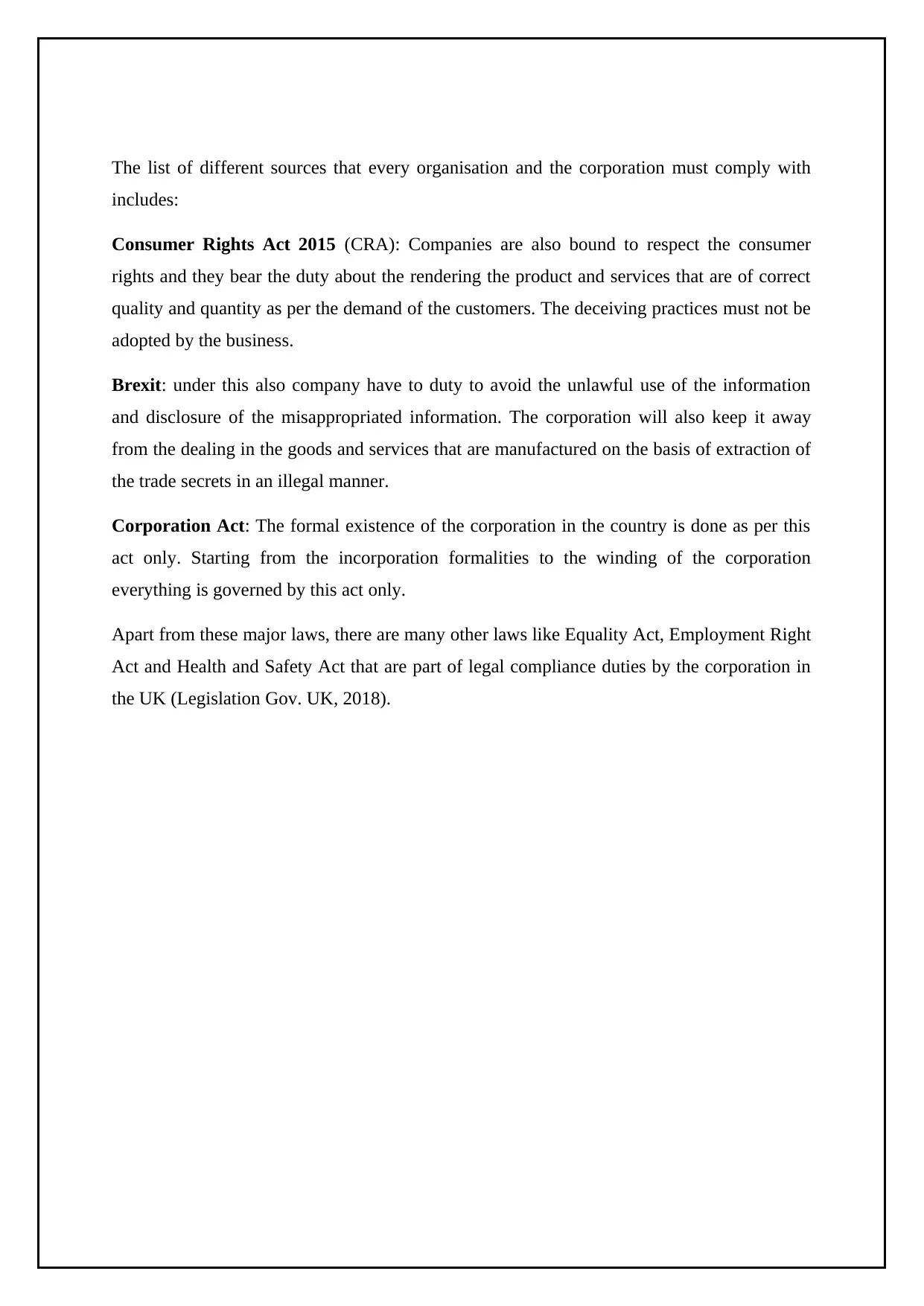
The list of different sources that every organisation and the corporation must comply with
includes:
Consumer Rights Act 2015 (CRA): Companies are also bound to respect the consumer
rights and they bear the duty about the rendering the product and services that are of correct
quality and quantity as per the demand of the customers. The deceiving practices must not be
adopted by the business.
Brexit: under this also company have to duty to avoid the unlawful use of the information
and disclosure of the misappropriated information. The corporation will also keep it away
from the dealing in the goods and services that are manufactured on the basis of extraction of
the trade secrets in an illegal manner.
Corporation Act: The formal existence of the corporation in the country is done as per this
act only. Starting from the incorporation formalities to the winding of the corporation
everything is governed by this act only.
Apart from these major laws, there are many other laws like Equality Act, Employment Right
Act and Health and Safety Act that are part of legal compliance duties by the corporation in
the UK (Legislation Gov. UK, 2018).
includes:
Consumer Rights Act 2015 (CRA): Companies are also bound to respect the consumer
rights and they bear the duty about the rendering the product and services that are of correct
quality and quantity as per the demand of the customers. The deceiving practices must not be
adopted by the business.
Brexit: under this also company have to duty to avoid the unlawful use of the information
and disclosure of the misappropriated information. The corporation will also keep it away
from the dealing in the goods and services that are manufactured on the basis of extraction of
the trade secrets in an illegal manner.
Corporation Act: The formal existence of the corporation in the country is done as per this
act only. Starting from the incorporation formalities to the winding of the corporation
everything is governed by this act only.
Apart from these major laws, there are many other laws like Equality Act, Employment Right
Act and Health and Safety Act that are part of legal compliance duties by the corporation in
the UK (Legislation Gov. UK, 2018).
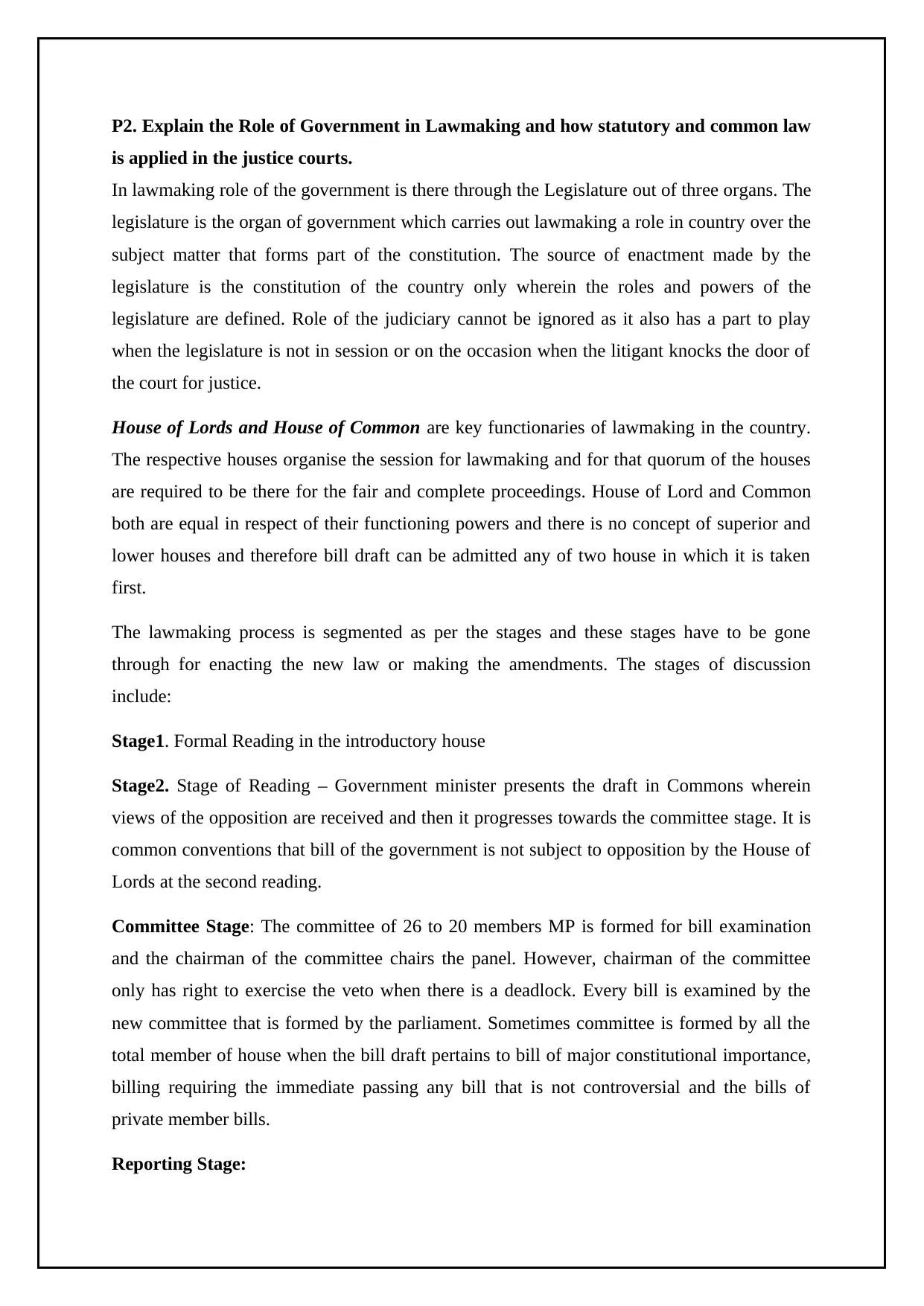
P2. Explain the Role of Government in Lawmaking and how statutory and common law
is applied in the justice courts.
In lawmaking role of the government is there through the Legislature out of three organs. The
legislature is the organ of government which carries out lawmaking a role in country over the
subject matter that forms part of the constitution. The source of enactment made by the
legislature is the constitution of the country only wherein the roles and powers of the
legislature are defined. Role of the judiciary cannot be ignored as it also has a part to play
when the legislature is not in session or on the occasion when the litigant knocks the door of
the court for justice.
House of Lords and House of Common are key functionaries of lawmaking in the country.
The respective houses organise the session for lawmaking and for that quorum of the houses
are required to be there for the fair and complete proceedings. House of Lord and Common
both are equal in respect of their functioning powers and there is no concept of superior and
lower houses and therefore bill draft can be admitted any of two house in which it is taken
first.
The lawmaking process is segmented as per the stages and these stages have to be gone
through for enacting the new law or making the amendments. The stages of discussion
include:
Stage1. Formal Reading in the introductory house
Stage2. Stage of Reading – Government minister presents the draft in Commons wherein
views of the opposition are received and then it progresses towards the committee stage. It is
common conventions that bill of the government is not subject to opposition by the House of
Lords at the second reading.
Committee Stage: The committee of 26 to 20 members MP is formed for bill examination
and the chairman of the committee chairs the panel. However, chairman of the committee
only has right to exercise the veto when there is a deadlock. Every bill is examined by the
new committee that is formed by the parliament. Sometimes committee is formed by all the
total member of house when the bill draft pertains to bill of major constitutional importance,
billing requiring the immediate passing any bill that is not controversial and the bills of
private member bills.
Reporting Stage:
is applied in the justice courts.
In lawmaking role of the government is there through the Legislature out of three organs. The
legislature is the organ of government which carries out lawmaking a role in country over the
subject matter that forms part of the constitution. The source of enactment made by the
legislature is the constitution of the country only wherein the roles and powers of the
legislature are defined. Role of the judiciary cannot be ignored as it also has a part to play
when the legislature is not in session or on the occasion when the litigant knocks the door of
the court for justice.
House of Lords and House of Common are key functionaries of lawmaking in the country.
The respective houses organise the session for lawmaking and for that quorum of the houses
are required to be there for the fair and complete proceedings. House of Lord and Common
both are equal in respect of their functioning powers and there is no concept of superior and
lower houses and therefore bill draft can be admitted any of two house in which it is taken
first.
The lawmaking process is segmented as per the stages and these stages have to be gone
through for enacting the new law or making the amendments. The stages of discussion
include:
Stage1. Formal Reading in the introductory house
Stage2. Stage of Reading – Government minister presents the draft in Commons wherein
views of the opposition are received and then it progresses towards the committee stage. It is
common conventions that bill of the government is not subject to opposition by the House of
Lords at the second reading.
Committee Stage: The committee of 26 to 20 members MP is formed for bill examination
and the chairman of the committee chairs the panel. However, chairman of the committee
only has right to exercise the veto when there is a deadlock. Every bill is examined by the
new committee that is formed by the parliament. Sometimes committee is formed by all the
total member of house when the bill draft pertains to bill of major constitutional importance,
billing requiring the immediate passing any bill that is not controversial and the bills of
private member bills.
Reporting Stage:
⊘ This is a preview!⊘
Do you want full access?
Subscribe today to unlock all pages.

Trusted by 1+ million students worldwide
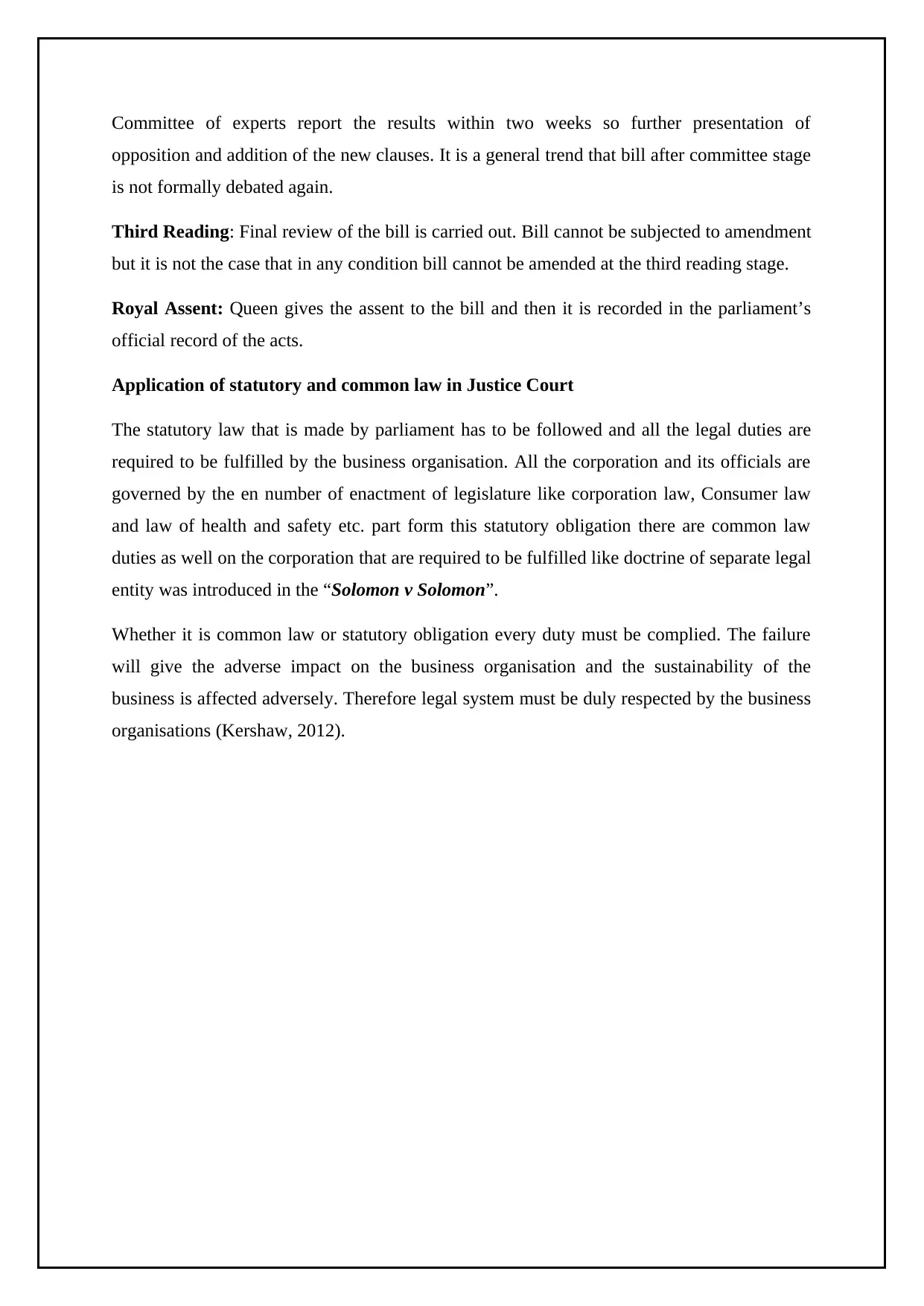
Committee of experts report the results within two weeks so further presentation of
opposition and addition of the new clauses. It is a general trend that bill after committee stage
is not formally debated again.
Third Reading: Final review of the bill is carried out. Bill cannot be subjected to amendment
but it is not the case that in any condition bill cannot be amended at the third reading stage.
Royal Assent: Queen gives the assent to the bill and then it is recorded in the parliament’s
official record of the acts.
Application of statutory and common law in Justice Court
The statutory law that is made by parliament has to be followed and all the legal duties are
required to be fulfilled by the business organisation. All the corporation and its officials are
governed by the en number of enactment of legislature like corporation law, Consumer law
and law of health and safety etc. part form this statutory obligation there are common law
duties as well on the corporation that are required to be fulfilled like doctrine of separate legal
entity was introduced in the “Solomon v Solomon”.
Whether it is common law or statutory obligation every duty must be complied. The failure
will give the adverse impact on the business organisation and the sustainability of the
business is affected adversely. Therefore legal system must be duly respected by the business
organisations (Kershaw, 2012).
opposition and addition of the new clauses. It is a general trend that bill after committee stage
is not formally debated again.
Third Reading: Final review of the bill is carried out. Bill cannot be subjected to amendment
but it is not the case that in any condition bill cannot be amended at the third reading stage.
Royal Assent: Queen gives the assent to the bill and then it is recorded in the parliament’s
official record of the acts.
Application of statutory and common law in Justice Court
The statutory law that is made by parliament has to be followed and all the legal duties are
required to be fulfilled by the business organisation. All the corporation and its officials are
governed by the en number of enactment of legislature like corporation law, Consumer law
and law of health and safety etc. part form this statutory obligation there are common law
duties as well on the corporation that are required to be fulfilled like doctrine of separate legal
entity was introduced in the “Solomon v Solomon”.
Whether it is common law or statutory obligation every duty must be complied. The failure
will give the adverse impact on the business organisation and the sustainability of the
business is affected adversely. Therefore legal system must be duly respected by the business
organisations (Kershaw, 2012).
Paraphrase This Document
Need a fresh take? Get an instant paraphrase of this document with our AI Paraphraser
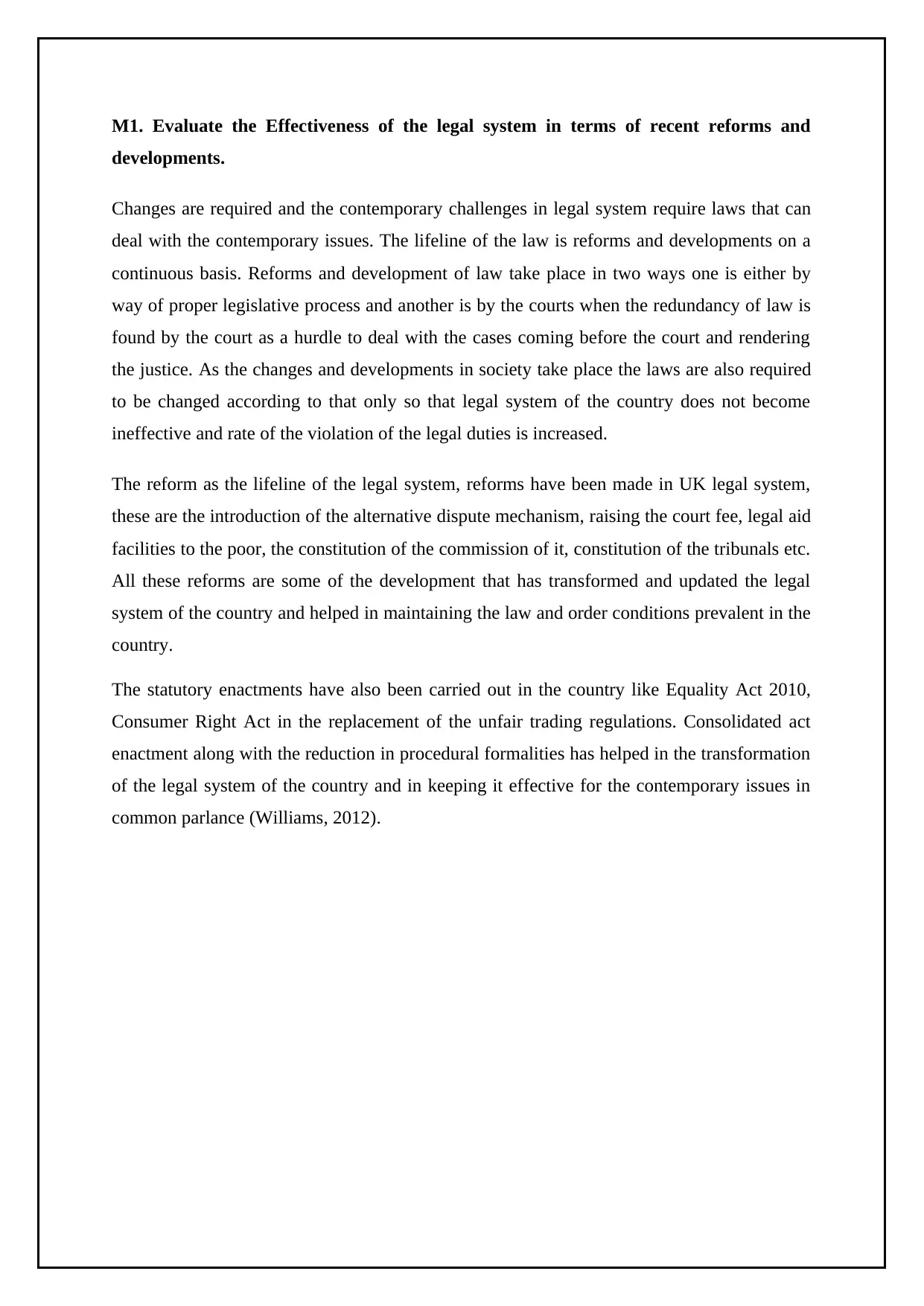
M1. Evaluate the Effectiveness of the legal system in terms of recent reforms and
developments.
Changes are required and the contemporary challenges in legal system require laws that can
deal with the contemporary issues. The lifeline of the law is reforms and developments on a
continuous basis. Reforms and development of law take place in two ways one is either by
way of proper legislative process and another is by the courts when the redundancy of law is
found by the court as a hurdle to deal with the cases coming before the court and rendering
the justice. As the changes and developments in society take place the laws are also required
to be changed according to that only so that legal system of the country does not become
ineffective and rate of the violation of the legal duties is increased.
The reform as the lifeline of the legal system, reforms have been made in UK legal system,
these are the introduction of the alternative dispute mechanism, raising the court fee, legal aid
facilities to the poor, the constitution of the commission of it, constitution of the tribunals etc.
All these reforms are some of the development that has transformed and updated the legal
system of the country and helped in maintaining the law and order conditions prevalent in the
country.
The statutory enactments have also been carried out in the country like Equality Act 2010,
Consumer Right Act in the replacement of the unfair trading regulations. Consolidated act
enactment along with the reduction in procedural formalities has helped in the transformation
of the legal system of the country and in keeping it effective for the contemporary issues in
common parlance (Williams, 2012).
developments.
Changes are required and the contemporary challenges in legal system require laws that can
deal with the contemporary issues. The lifeline of the law is reforms and developments on a
continuous basis. Reforms and development of law take place in two ways one is either by
way of proper legislative process and another is by the courts when the redundancy of law is
found by the court as a hurdle to deal with the cases coming before the court and rendering
the justice. As the changes and developments in society take place the laws are also required
to be changed according to that only so that legal system of the country does not become
ineffective and rate of the violation of the legal duties is increased.
The reform as the lifeline of the legal system, reforms have been made in UK legal system,
these are the introduction of the alternative dispute mechanism, raising the court fee, legal aid
facilities to the poor, the constitution of the commission of it, constitution of the tribunals etc.
All these reforms are some of the development that has transformed and updated the legal
system of the country and helped in maintaining the law and order conditions prevalent in the
country.
The statutory enactments have also been carried out in the country like Equality Act 2010,
Consumer Right Act in the replacement of the unfair trading regulations. Consolidated act
enactment along with the reduction in procedural formalities has helped in the transformation
of the legal system of the country and in keeping it effective for the contemporary issues in
common parlance (Williams, 2012).
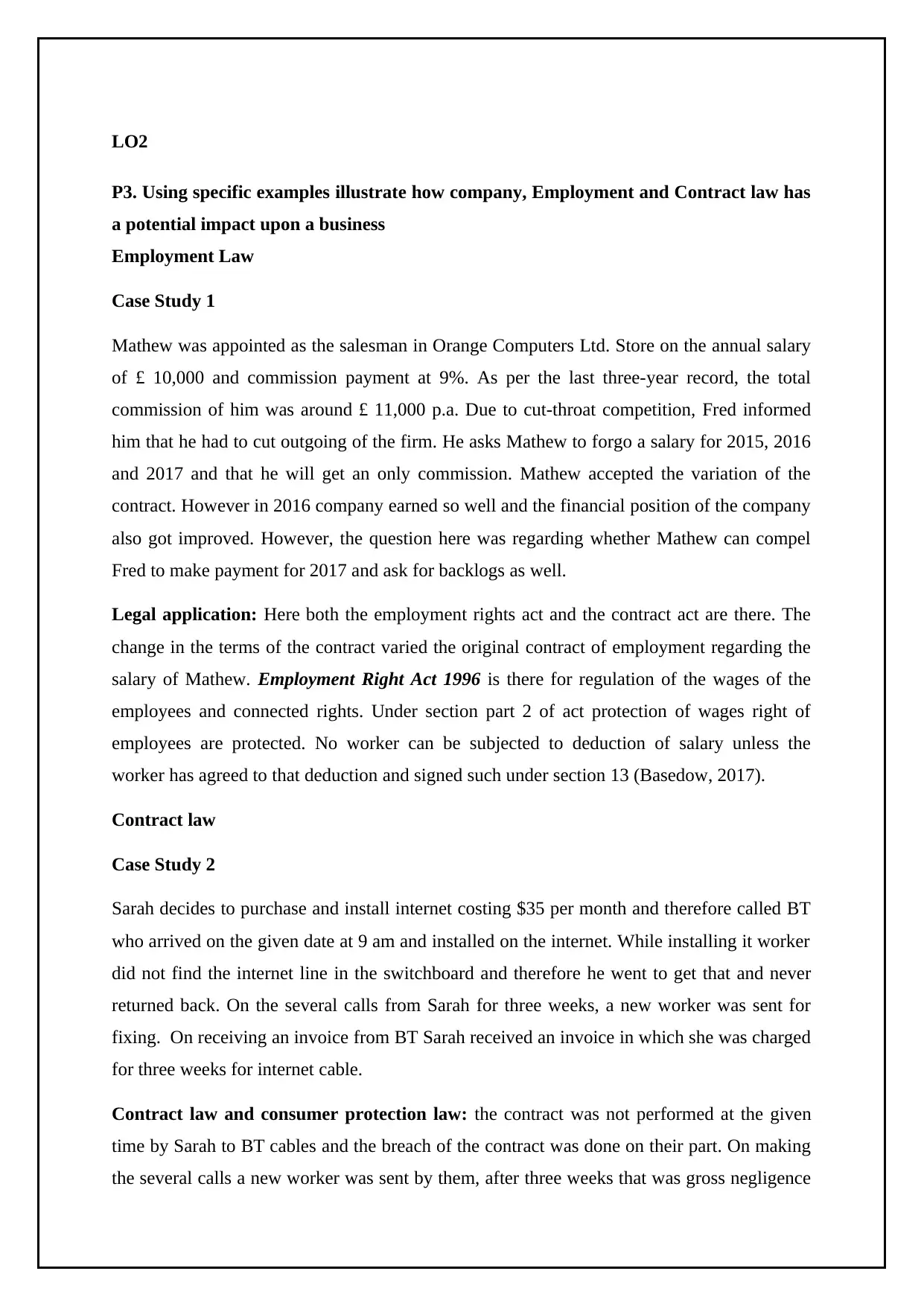
LO2
P3. Using specific examples illustrate how company, Employment and Contract law has
a potential impact upon a business
Employment Law
Case Study 1
Mathew was appointed as the salesman in Orange Computers Ltd. Store on the annual salary
of £ 10,000 and commission payment at 9%. As per the last three-year record, the total
commission of him was around £ 11,000 p.a. Due to cut-throat competition, Fred informed
him that he had to cut outgoing of the firm. He asks Mathew to forgo a salary for 2015, 2016
and 2017 and that he will get an only commission. Mathew accepted the variation of the
contract. However in 2016 company earned so well and the financial position of the company
also got improved. However, the question here was regarding whether Mathew can compel
Fred to make payment for 2017 and ask for backlogs as well.
Legal application: Here both the employment rights act and the contract act are there. The
change in the terms of the contract varied the original contract of employment regarding the
salary of Mathew. Employment Right Act 1996 is there for regulation of the wages of the
employees and connected rights. Under section part 2 of act protection of wages right of
employees are protected. No worker can be subjected to deduction of salary unless the
worker has agreed to that deduction and signed such under section 13 (Basedow, 2017).
Contract law
Case Study 2
Sarah decides to purchase and install internet costing $35 per month and therefore called BT
who arrived on the given date at 9 am and installed on the internet. While installing it worker
did not find the internet line in the switchboard and therefore he went to get that and never
returned back. On the several calls from Sarah for three weeks, a new worker was sent for
fixing. On receiving an invoice from BT Sarah received an invoice in which she was charged
for three weeks for internet cable.
Contract law and consumer protection law: the contract was not performed at the given
time by Sarah to BT cables and the breach of the contract was done on their part. On making
the several calls a new worker was sent by them, after three weeks that was gross negligence
P3. Using specific examples illustrate how company, Employment and Contract law has
a potential impact upon a business
Employment Law
Case Study 1
Mathew was appointed as the salesman in Orange Computers Ltd. Store on the annual salary
of £ 10,000 and commission payment at 9%. As per the last three-year record, the total
commission of him was around £ 11,000 p.a. Due to cut-throat competition, Fred informed
him that he had to cut outgoing of the firm. He asks Mathew to forgo a salary for 2015, 2016
and 2017 and that he will get an only commission. Mathew accepted the variation of the
contract. However in 2016 company earned so well and the financial position of the company
also got improved. However, the question here was regarding whether Mathew can compel
Fred to make payment for 2017 and ask for backlogs as well.
Legal application: Here both the employment rights act and the contract act are there. The
change in the terms of the contract varied the original contract of employment regarding the
salary of Mathew. Employment Right Act 1996 is there for regulation of the wages of the
employees and connected rights. Under section part 2 of act protection of wages right of
employees are protected. No worker can be subjected to deduction of salary unless the
worker has agreed to that deduction and signed such under section 13 (Basedow, 2017).
Contract law
Case Study 2
Sarah decides to purchase and install internet costing $35 per month and therefore called BT
who arrived on the given date at 9 am and installed on the internet. While installing it worker
did not find the internet line in the switchboard and therefore he went to get that and never
returned back. On the several calls from Sarah for three weeks, a new worker was sent for
fixing. On receiving an invoice from BT Sarah received an invoice in which she was charged
for three weeks for internet cable.
Contract law and consumer protection law: the contract was not performed at the given
time by Sarah to BT cables and the breach of the contract was done on their part. On making
the several calls a new worker was sent by them, after three weeks that was gross negligence
⊘ This is a preview!⊘
Do you want full access?
Subscribe today to unlock all pages.

Trusted by 1+ million students worldwide
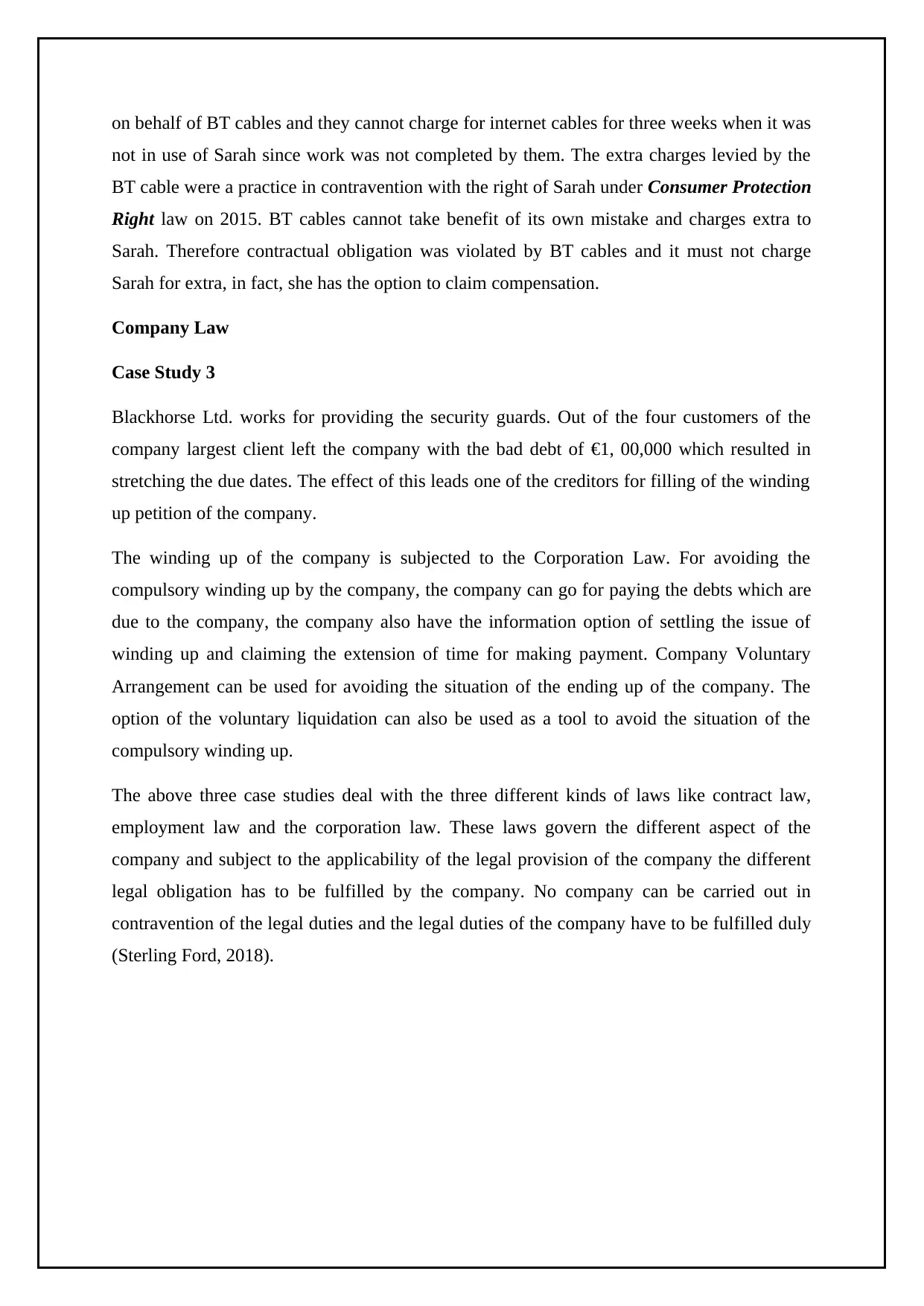
on behalf of BT cables and they cannot charge for internet cables for three weeks when it was
not in use of Sarah since work was not completed by them. The extra charges levied by the
BT cable were a practice in contravention with the right of Sarah under Consumer Protection
Right law on 2015. BT cables cannot take benefit of its own mistake and charges extra to
Sarah. Therefore contractual obligation was violated by BT cables and it must not charge
Sarah for extra, in fact, she has the option to claim compensation.
Company Law
Case Study 3
Blackhorse Ltd. works for providing the security guards. Out of the four customers of the
company largest client left the company with the bad debt of €1, 00,000 which resulted in
stretching the due dates. The effect of this leads one of the creditors for filling of the winding
up petition of the company.
The winding up of the company is subjected to the Corporation Law. For avoiding the
compulsory winding up by the company, the company can go for paying the debts which are
due to the company, the company also have the information option of settling the issue of
winding up and claiming the extension of time for making payment. Company Voluntary
Arrangement can be used for avoiding the situation of the ending up of the company. The
option of the voluntary liquidation can also be used as a tool to avoid the situation of the
compulsory winding up.
The above three case studies deal with the three different kinds of laws like contract law,
employment law and the corporation law. These laws govern the different aspect of the
company and subject to the applicability of the legal provision of the company the different
legal obligation has to be fulfilled by the company. No company can be carried out in
contravention of the legal duties and the legal duties of the company have to be fulfilled duly
(Sterling Ford, 2018).
not in use of Sarah since work was not completed by them. The extra charges levied by the
BT cable were a practice in contravention with the right of Sarah under Consumer Protection
Right law on 2015. BT cables cannot take benefit of its own mistake and charges extra to
Sarah. Therefore contractual obligation was violated by BT cables and it must not charge
Sarah for extra, in fact, she has the option to claim compensation.
Company Law
Case Study 3
Blackhorse Ltd. works for providing the security guards. Out of the four customers of the
company largest client left the company with the bad debt of €1, 00,000 which resulted in
stretching the due dates. The effect of this leads one of the creditors for filling of the winding
up petition of the company.
The winding up of the company is subjected to the Corporation Law. For avoiding the
compulsory winding up by the company, the company can go for paying the debts which are
due to the company, the company also have the information option of settling the issue of
winding up and claiming the extension of time for making payment. Company Voluntary
Arrangement can be used for avoiding the situation of the ending up of the company. The
option of the voluntary liquidation can also be used as a tool to avoid the situation of the
compulsory winding up.
The above three case studies deal with the three different kinds of laws like contract law,
employment law and the corporation law. These laws govern the different aspect of the
company and subject to the applicability of the legal provision of the company the different
legal obligation has to be fulfilled by the company. No company can be carried out in
contravention of the legal duties and the legal duties of the company have to be fulfilled duly
(Sterling Ford, 2018).
Paraphrase This Document
Need a fresh take? Get an instant paraphrase of this document with our AI Paraphraser
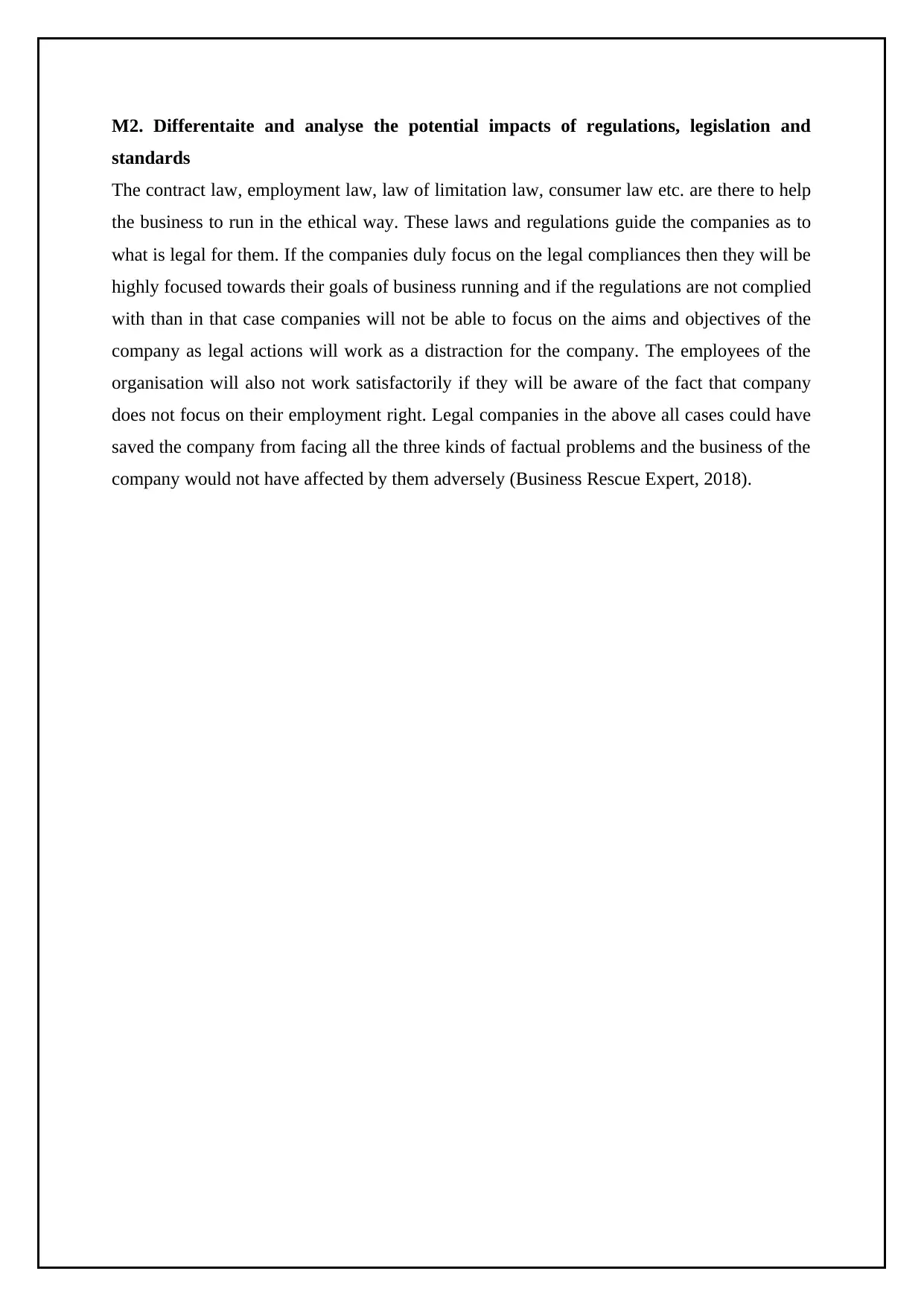
M2. Differentaite and analyse the potential impacts of regulations, legislation and
standards
The contract law, employment law, law of limitation law, consumer law etc. are there to help
the business to run in the ethical way. These laws and regulations guide the companies as to
what is legal for them. If the companies duly focus on the legal compliances then they will be
highly focused towards their goals of business running and if the regulations are not complied
with than in that case companies will not be able to focus on the aims and objectives of the
company as legal actions will work as a distraction for the company. The employees of the
organisation will also not work satisfactorily if they will be aware of the fact that company
does not focus on their employment right. Legal companies in the above all cases could have
saved the company from facing all the three kinds of factual problems and the business of the
company would not have affected by them adversely (Business Rescue Expert, 2018).
standards
The contract law, employment law, law of limitation law, consumer law etc. are there to help
the business to run in the ethical way. These laws and regulations guide the companies as to
what is legal for them. If the companies duly focus on the legal compliances then they will be
highly focused towards their goals of business running and if the regulations are not complied
with than in that case companies will not be able to focus on the aims and objectives of the
company as legal actions will work as a distraction for the company. The employees of the
organisation will also not work satisfactorily if they will be aware of the fact that company
does not focus on their employment right. Legal companies in the above all cases could have
saved the company from facing all the three kinds of factual problems and the business of the
company would not have affected by them adversely (Business Rescue Expert, 2018).
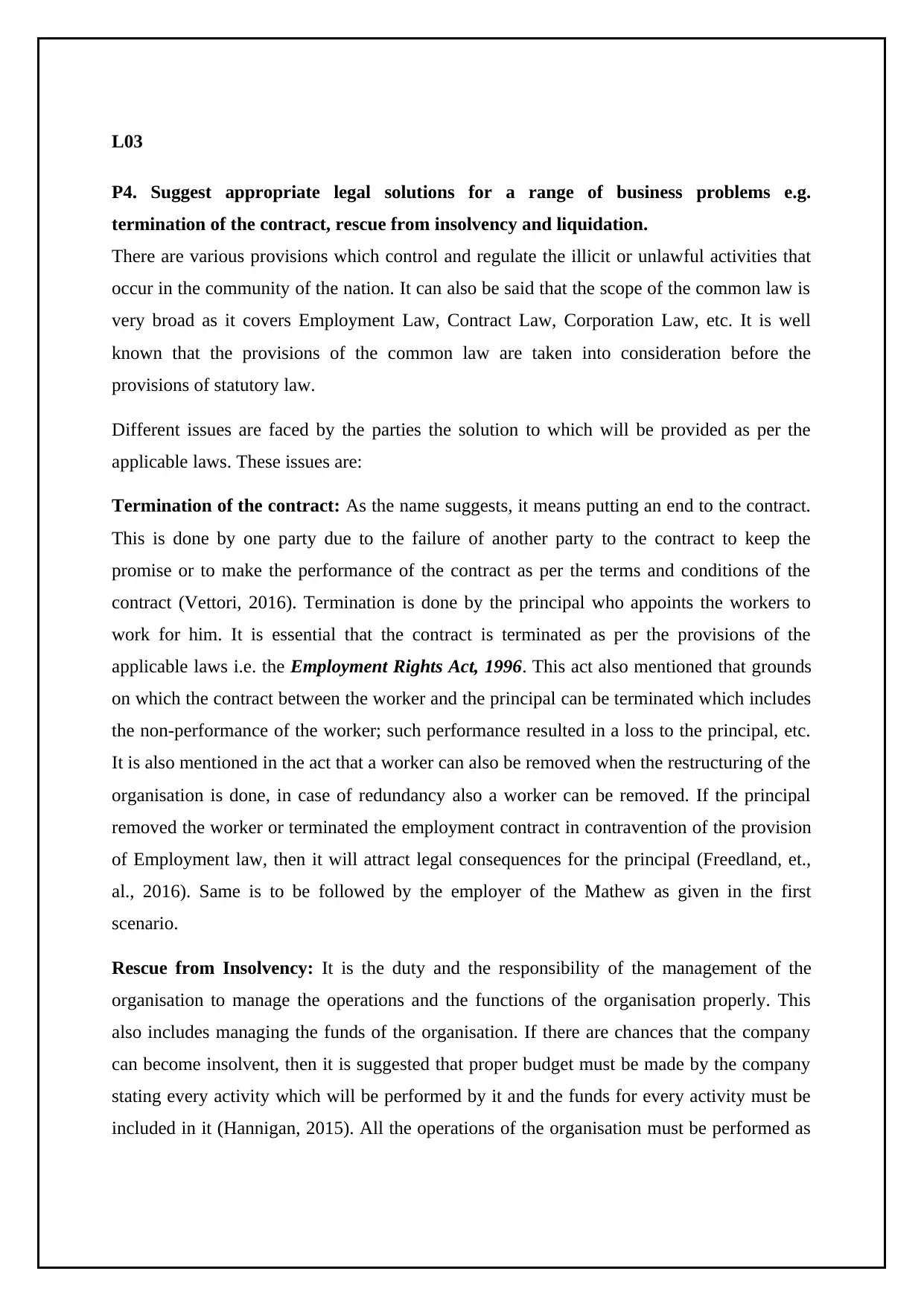
L03
P4. Suggest appropriate legal solutions for a range of business problems e.g.
termination of the contract, rescue from insolvency and liquidation.
There are various provisions which control and regulate the illicit or unlawful activities that
occur in the community of the nation. It can also be said that the scope of the common law is
very broad as it covers Employment Law, Contract Law, Corporation Law, etc. It is well
known that the provisions of the common law are taken into consideration before the
provisions of statutory law.
Different issues are faced by the parties the solution to which will be provided as per the
applicable laws. These issues are:
Termination of the contract: As the name suggests, it means putting an end to the contract.
This is done by one party due to the failure of another party to the contract to keep the
promise or to make the performance of the contract as per the terms and conditions of the
contract (Vettori, 2016). Termination is done by the principal who appoints the workers to
work for him. It is essential that the contract is terminated as per the provisions of the
applicable laws i.e. the Employment Rights Act, 1996. This act also mentioned that grounds
on which the contract between the worker and the principal can be terminated which includes
the non-performance of the worker; such performance resulted in a loss to the principal, etc.
It is also mentioned in the act that a worker can also be removed when the restructuring of the
organisation is done, in case of redundancy also a worker can be removed. If the principal
removed the worker or terminated the employment contract in contravention of the provision
of Employment law, then it will attract legal consequences for the principal (Freedland, et.,
al., 2016). Same is to be followed by the employer of the Mathew as given in the first
scenario.
Rescue from Insolvency: It is the duty and the responsibility of the management of the
organisation to manage the operations and the functions of the organisation properly. This
also includes managing the funds of the organisation. If there are chances that the company
can become insolvent, then it is suggested that proper budget must be made by the company
stating every activity which will be performed by it and the funds for every activity must be
included in it (Hannigan, 2015). All the operations of the organisation must be performed as
P4. Suggest appropriate legal solutions for a range of business problems e.g.
termination of the contract, rescue from insolvency and liquidation.
There are various provisions which control and regulate the illicit or unlawful activities that
occur in the community of the nation. It can also be said that the scope of the common law is
very broad as it covers Employment Law, Contract Law, Corporation Law, etc. It is well
known that the provisions of the common law are taken into consideration before the
provisions of statutory law.
Different issues are faced by the parties the solution to which will be provided as per the
applicable laws. These issues are:
Termination of the contract: As the name suggests, it means putting an end to the contract.
This is done by one party due to the failure of another party to the contract to keep the
promise or to make the performance of the contract as per the terms and conditions of the
contract (Vettori, 2016). Termination is done by the principal who appoints the workers to
work for him. It is essential that the contract is terminated as per the provisions of the
applicable laws i.e. the Employment Rights Act, 1996. This act also mentioned that grounds
on which the contract between the worker and the principal can be terminated which includes
the non-performance of the worker; such performance resulted in a loss to the principal, etc.
It is also mentioned in the act that a worker can also be removed when the restructuring of the
organisation is done, in case of redundancy also a worker can be removed. If the principal
removed the worker or terminated the employment contract in contravention of the provision
of Employment law, then it will attract legal consequences for the principal (Freedland, et.,
al., 2016). Same is to be followed by the employer of the Mathew as given in the first
scenario.
Rescue from Insolvency: It is the duty and the responsibility of the management of the
organisation to manage the operations and the functions of the organisation properly. This
also includes managing the funds of the organisation. If there are chances that the company
can become insolvent, then it is suggested that proper budget must be made by the company
stating every activity which will be performed by it and the funds for every activity must be
included in it (Hannigan, 2015). All the operations of the organisation must be performed as
⊘ This is a preview!⊘
Do you want full access?
Subscribe today to unlock all pages.

Trusted by 1+ million students worldwide
1 out of 21
Related Documents
Your All-in-One AI-Powered Toolkit for Academic Success.
+13062052269
info@desklib.com
Available 24*7 on WhatsApp / Email
![[object Object]](/_next/static/media/star-bottom.7253800d.svg)
Unlock your academic potential
Copyright © 2020–2025 A2Z Services. All Rights Reserved. Developed and managed by ZUCOL.





